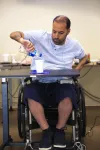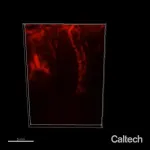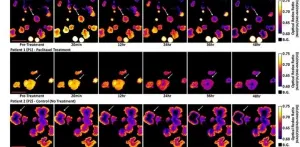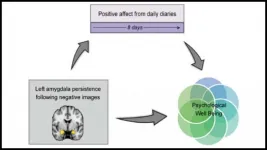(Press-News.org) East Hanover, NJ. March 22, 2021. Kessler Foundation researchers demonstrated that spinal cord transcutaneous stimulation (scTS) combined with hand training improves upper extremity and hand function in individuals with motor and sensory compete spinal cord injury (SCI). The study results showed immediate and long-lasting gains in strength, sensibility, and voluntary motor function.
The article, "Cervical Spinal Cord Transcutaneous Stimulation Improves Upper Extremity and Hand Function in People with Complete Tetraplegia: A Case Study" (doi: 10.1109/TNSRE.2020.3048592), was published January 28, 2021, in IEEE Transactions On Neural Systems And Rehabilitation Engineering. It is available open access at https://ieeexplore.ieee.org/document/9311628.
The authors are Fan Zhang, PhD, Kamyar Momeni, PhD, Arvind Ramanujam, MS, Manikandan Ravi, MS, Janelle Carnahan, PT, Steven Kirshblum, MD, and Gail F. Forrest, PhD, affiliated with the Center for Mobility and Rehabilitation Engineering Research and the Tim and Caroline Reynolds Center for Spinal Stimulation at Kessler Foundation.
For people with tetraplegia, recovering hand and upper extremity function is a top priority, as it allows them to regain the ability to perform some everyday tasks. Even a small degree of functional improvement can bring with it increased independence, vastly improving their quality of life.
While previous studies have investigated whether scTS is effective in improving upper extremity and hand function in individuals with motor complete and incomplete cervical SCI, it remained unclear whether scTS can facilitate functional restoration in an individual with motor and sensory complete tetraplegia, according to lead author Dr. Zhang, an associate research scientist at the Reynolds Center for Spinal Stimulation. Moreover, previous studies did not report follow-up testing, leaving open the question of whether scTS had long-lasting benefit.
In this case study, investigators examined the short-term and three-month post-intervention therapeutic effects of non-invasive scTS in restoring upper extremity and hand function in an individual with chronic complete cervical SCI. The study participant, a 38-year-old male who sustained his injury 15 years before study participation, received 18 scTS sessions combined with task-specific hand training over the course of 8 weeks.
Results revealed significant and long-lasting improvements in upper extremity and hand function. The total score of the Graded Redefined Assessment of Strength, Sensibility, and Prehension improved from 72/232 at baseline to 96/232 at post-intervention, and scores maintained a range from 82/232 to 86/232 during three-month follow-up without any further treatment. Bilateral handgrip force also improved by 283.4 percent in the left, dominant hand, and 30.7 percent in the right hand. These strength gains were sustained at 233.5 percent to 250 percent in the left hand and 11.5 percent to 73.1 percent in the right hand during follow-up evaluation visits.
In addition, changes in spinal motor evoked potentials (sMEP), a neurophysiological test, showed an increased level of spinal network excitability, indicating that scTS can potentially neuro-modulate the spinal network into restoring function in paralyzed limbs.
"We saw both immediate and sustained improvements on handgrip strength and motor control in this participant with complete tetraplegia," said Dr. Zhang. "From the very first session of applying scTS, he demonstrated an immediate enhancement in grip strength." He added, "Voluntary motor control dramatically improved within one single session, with the participant able to successfully lift a water bottle and grasp a tennis ball with stimulation enabled, neither of which were possible without stimulation."
INFORMATION:
Dr. Zhang conducted this research during his postdoctoral fellowship funded by the National Institute on Disability Independent Living and Rehabilitation Research (NIDILRR). He was one of five NIDILRR fellows recognized at the 2020 Young Investigators Symposium at the 97th Annual Conference of the American Congress of Rehabilitation Medicine.
Funding sources: Tim Reynolds Foundation; National Institute on Disability, Independent Living, and Rehabilitation Research (90RE5021-01-00, ARRT 90ARHF0002
About Kessler Foundation
Kessler Foundation, a major nonprofit organization in the field of disability, is a global leader in rehabilitation research that seeks to improve cognition, mobility and long-term outcomes, including employment, for people with neurological disabilities caused by diseases and injuries of the brain and spinal cord. Kessler Foundation leads the nation in funding innovative programs that expand opportunities for employment for people with disabilities.
For more information, visit KesslerFoundation.org.
For more information, or to interview an expert, contact: Carolann Murphy, 973.324.8382, CMurphy@KesslerFoundation.org
What is happening in your brain as you are scrolling through this page? In other words, which areas of your brain are active, which neurons are talking to which others, and what signals are they sending to your muscles?
Mapping neural activity to corresponding behaviors is a major goal for neuroscientists developing brain-machine interfaces (BMIs): devices that read and interpret brain activity and transmit instructions to a computer or machine. Though this may seem like science fiction, existing BMIs can, for example, connect a paralyzed person with a robotic ...
The pandemic has exposed weaknesses in nursing homes, causing many families to rethink whether to keep an aging parent at home instead. Now a new study by UC San Francisco has found that many elderly Americans lack the basic self-care equipment that could enable them to live at home longer, postponing the need to move into residential care facilities.
In the study, researchers focused on three inexpensive, low-tech assistive devices: grab bars around the toilet and in the shower or tub area; a shower or tub seat; and a raised toilet or toilet seat. They identified approximately 2,600 seniors who were representative of Medicare recipients nationwide and were drawn from the National Health and Aging ...
Social deficits attract so much attention in the study of autism spectrum disorder, it's easy to forget there are motor learning deficits during early childhood as well. For autistic kids hoping to throw a ball around the schoolyard and connect with classmates, these physical skill differences can isolate a child further.
In a new study published in Nature Neuroscience, researchers from the University of Ottawa's Faculty of Medicine have closed in on the neurological underpinnings of the motor learning delay.
Dr. Simon Chen's lab in the Department of Cellular and Molecular Medicine of the Faculty of Medicine used a mouse model of autism to demonstrate a shortage ...
Though 40 million concussions are recorded annually, no effective treatment exists for them or for many other brain-related illnesses. In collaboration with Dragan Maric of the National Institutes of Health, Badri Roysam, Hugh Roy and Lillie Cranz Cullen University Professor and Chair of Electrical and Computer Engineering, and his team are working to speed up drug development to treat brain diseases and injuries like concussion by developing new tools.
"We are interested in mapping and profiling unhealthy and drug-treated brain tissue in unprecedented detail to reveal multiple biological processes at once - in context," said Roysam about his latest paper published ...
NEW YORK, NY (March 22, 2021)--The first year of the COVID-19 pandemic has taken the lives of millions of people around the world but has also left hundreds with lingering symptoms or completely new symptoms weeks after recovery.
Much is unknown about what causes these symptoms and how long they last. But with nearly 740,000 cases of COVID reported in New York City since last March--and 28 million in the United States--physicians are increasingly seeing these "long-haulers" in their practices.
"Over the course of the summer, we started getting a sense of what issues these people were having," ...
Organoids are tiny three-dimensional cellular assemblies that are grown in a laboratory from tissue-specific cells. They are particularly interesting to biologists because of their ability to mimic the characteristics of the original tissues. If scientists extract cells from a tumor, then they can grow cancer organoids that mimic the characteristics of the source tumor.
This possibility for individual-level studies of tumor properties makes cancer organoids an exciting tool from the perspective of an emerging field called precision cancer medicine. Daniel Gil of the University of Wisconsin ...
CLEVELAND--A new technique for sampling and testing cells from Barrett's esophagus (BE) patients could result in earlier and easier identification of patients whose disease has progressed toward cancer or whose disease is at high risk of progressing toward cancer, according to a collaborative study by investigators at Case Western Reserve University and Johns Hopkins Kimmel Cancer Center (JHKCC).
Published in the journal Gastroenterology, the findings show the combination of esophageal "brushing" with a massively parallel sequencing method can provide an accurate assessment of the ...
For something we spend one-third of our lives doing, we still understand remarkably little about how sleep works -- for example, why can some people sleep deeply through any disturbance, while others regularly toss and turn for hours each night? And why do we all seem to need a different amount of sleep to feel rested?
For decades, scientists have looked to the behavior of the brain's neurons to understand the nature of slumber. Now, though, researchers at UC San Francisco have confirmed that a different type of brain cell that has received far less study -- astrocytes, named for their star-like shape -- can influence how long and how deeply animals sleep. The findings could open new avenues for exploring sleep disorder therapies and help scientists better understand brain diseases linked ...
A large study of brain MRI scans from 11,679 nine- and ten-year-old children reviewed by UC San Francisco neuroradiologists identified potentially life-threatening conditions in 1 in 500 children, and more minor but possibly clinically significant brain abnormalities in 1 out of 25 children.
The results provide the best estimates to date of the true incidence of various structural abnormalities in the developing brain, and raise the question of whether all MRI brain imaging obtained during research studies should be reviewed by board-certified radiologists, as was done in this study, in the hopes of saving lives and alerting participants to incidental findings that ought to be medically evaluated.
One ...
How the amygdala responds to viewing negative and subsequent neutral stimuli may impact our daily mood, according to new research published in JNeurosci.
The amygdala evaluates the environment to find potential threats. If a threat does appear, the amygdala can stay active and respond to new stimuli like they are threatening too. This is helpful when you are in a dangerous situation, but less so when spilling your coffee in the morning keeps you on edge for the rest of the day.
In a recent study, Puccetti et al. examined data collected from the "Midlife ...





